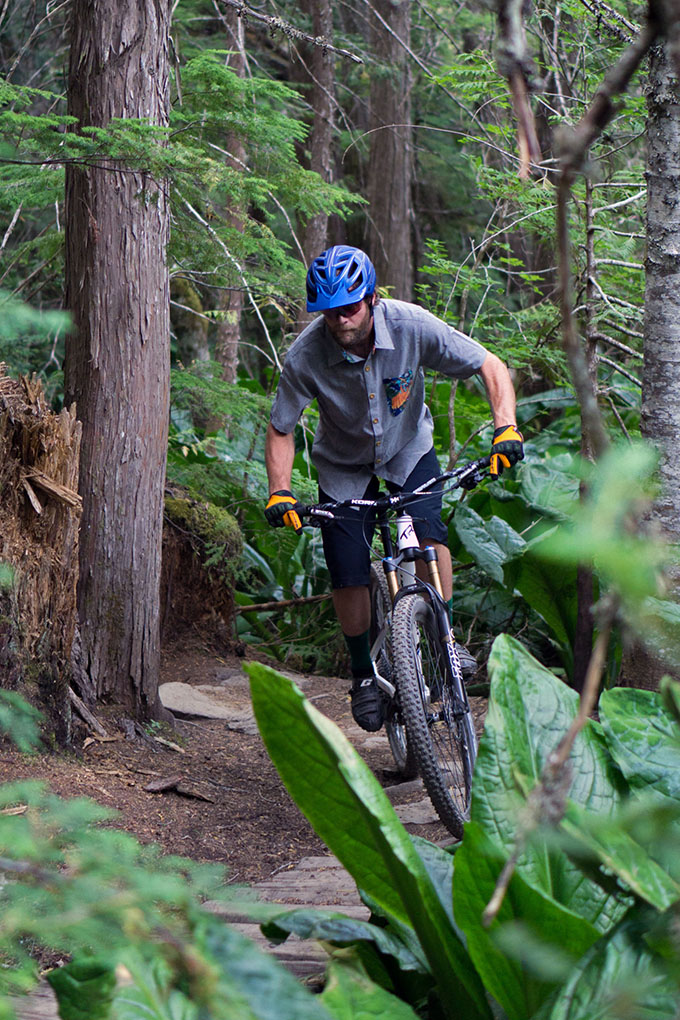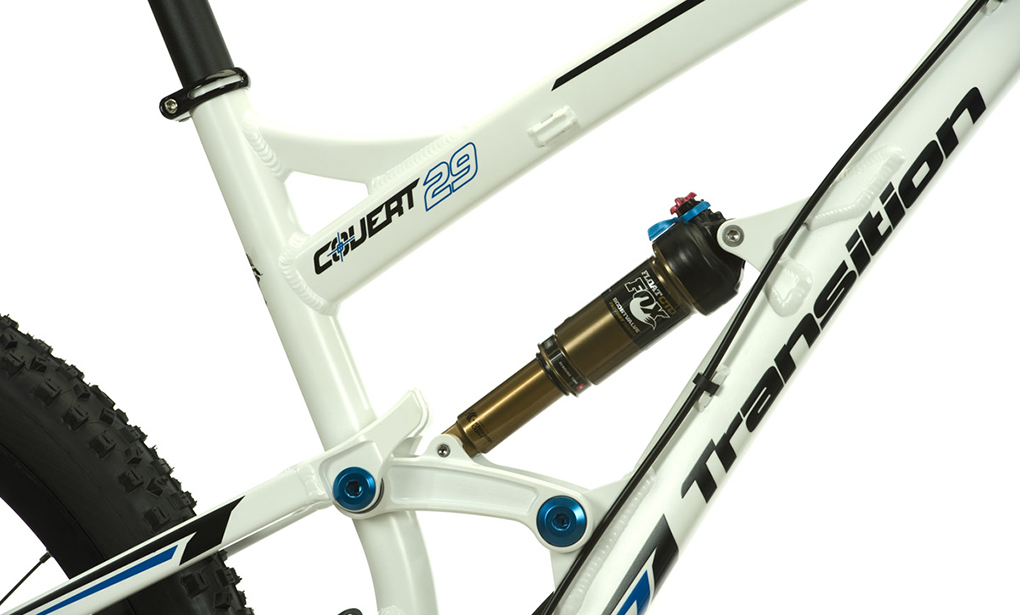The Build
Transition offers the Covert 29 with three different build kits, and alone as a frameset. In this respect Transition does an excellent job of providing a number of choices for riders to find a bike that fits their budget. The top-end Covert 1 will cost you $4799, while the Covert 3 is the most affordable model at $2799. A Covert frame with a shock will set you back $1549.
I spent the week riding the Covert 2 ($3799), Transition’s middle-of-the-road build, set up with a Shimano SLX drivetrain and brakes, a Fox Float 34 CTD fork, Fox Float CTD shock w/ trail adjust, and Transition’s house brand Revolution wheelset. I was disappointed to find that none of the Covert models come stock with a dropper post, but Transition does offer it as a $300 upgrade. (In my opinion, any bike costing $3-4000 that is marketed as an All-Mountain or Enduro bike should have an OEM dropper post.)
Transition specs their bikes with a few parts that can be easily modified, giving riders options to fine tune the bike to their liking. For example, the Covert 29 came with 800mm Kore OCD handlebars, which are wide by anyone’s standard. 31.5” is a lot of bar, especially when navigating tight, twisty technical trails. My first trail on the Covert 29 was a slow-speed balance contest with lots of techy bridges and skinnies, and I felt like a beginner trying to thread the bars through tight sections without smashing my fingers.

But Transition knows that the handlebar mentality these days seems to be wider = better, so they spec their bikes with wide bars giving you the option to cut them down to your preferred length. I definitely would be inclined to cut the bars down to 760mm (what I typically ride).
As for the Covert 29’s suspension components, the Fox CTD dampers left something to be desired. In Descend mode, I found that the Float CTD rear shock blew through its travel way too easily on small drops and high speed corners, which I’ll say more about below.
Up front, the Fox 34 fork absorbed roots and rocks fairly well, although it wasn’t nearly as supple in the beginning of its stroke as the forks on some other bikes we tested, namely the RockShox Pike. At slower speeds the sticky feel of the Fox fork tended to make the bike a little harsh, where small bump sensitivity was concerned. This was most noticeable during slow, hard braking on steep set-up sections, right before letting off the brakes to roll down a rock face into a transition. I also noticed some flex in the fork on hard cornering and slight deflection in the front end at high speeds (something a larger 20mm axle may have helped resolve).
There’s one big caveat here, however; the bike we tested was brand new and was only ridden for a week during the test, so the suspension didn’t have a chance to properly break in. This certainly helps explain the dampers’ poor small-bump compliance and chattery feel in loose rocks. Their bushings didn’t have nearly enough time to break in and become more sensitive. Having owned Fox forks and shocks in the past, I can attest to their lengthy break-in period and need for regular oil changes. Given another month of riding, I would expect the small bump sensitivity of both dampers to improve
The house-branded Transition Revolution wheelset ended up taking a few blows during the week of testing, but held up pretty well for an entry-level wheelset. I did manage to put a decent sized flat spot in the rear rim after a particularly nasty rock-root–chute-slide with a sharp rock at the bottom. I’m confident that this would have happened to any other rim out there, and it is worth noting that spoke tension held and the wheel still spun true even after the impact.
Most companies seem to spec house-branded, low-end wheels on bikes costing under $5000, and the same is true for Transition and the Revo wheels. The Revo’s are nothing special; they’re cheap ($349 for the set) and heavy (2277g). By comparison, Sun Ringle’s entry-level Black Flag Comp is roughly the same price, and is ½ pound (305g) lighter. The Black Flags also come tubeless-ready, whereas the Revo’s would need to be retrofitted with tubeless rim strips (which would cost and additional $30). If I were in the market for a Covert 29, I’d plan to swap out the Revo wheels for something lighter with a tubeless option and a better engaging rear hub.
The Ride
In good humor, Transition employs their “Basically Aligned Linear Leverage System” (B.A.L.L.S.) suspension on the Covert family. This single pivot driven faux-bar linkage uses a high main pivot to help with pedaling efficiency, while also retaining good bump compliance.
”Our B.A.L.L.S. are only there to make sure you have fun on the trail,” says Transition owner Kevin Menard. “Unlike other suspension systems, our B.A.L.L.S. aren’t overly complicated — it’s just the right suspension technology to keep the ride smooth and predictable.”

Pedaling Efficiency
The Covert 29’s B.A.L.L.S. rear end does a good job of absorbing bumps and remains predictable on descents, but it doesn’t work as well when you lay the power down. In Descend mode, the Covert 29 bobbed significantly when I moved from a sitting to standing standing position on the bike (a move that often exacerbates any pedaling efficiency problems with a suspension design). This is easily, but only partially, remedied by the Climb-mode on the rear shock, which effectively locks out the bike’s rear end. For roads and smooth climbs there’s no problem with riding with the Covert 29’s rear end locked out, but in areas like Whistler with steep, technical climbs that require traction, a more active rear end is definitely preferable, as it allows the rear wheel to contour over bumps.
A focus on bump compliance at the expense of pedaling performance is common with a faux-bar linkage like the Covert 29’s. Faux-bar bikes rely on the shock rather than the linkage itself to negate pedaling forces. The Covert 29 is no exception to this general rule, and uses the Fox shock’s lock out as a crutch for better pedaling performance. With the rear shock in Trail mode (a moderate low-speed compression setting), I was able to get the grip I needed on punchy sections on the Covert 29, but I could still feel the power-robbing bob in the rear end.
Weighing 32 lbs and equipped with a 2×10 drivetrain, the Covert 29 will tolerate most climbs, but it won’t be the fastest bike to the top. The bike is definitely stronger on the descent.

The Covert 29 has a majorly regressive leverage curve – not surprised it was bottoming out all the time. Very different from the linear design of the smaller wheeled versions. Afraid volume spacers may not do the trick – just too regressive.
Anywhere I can see a graph of that curve? or know what the ideal shock for it might be?